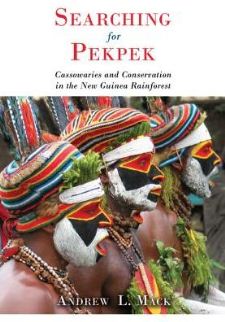Reviewed by Grant McCreary on April 17th, 2014.
I’ve often wondered what it would be like to be a field ornithologist – to be out there researching birds, especially in some far-off, exotic location. Maybe somewhere like Papua New Guinea? Relatively pristine rain forest, incredible birds like cassowaries and birds-of-paradise – it sounds wonderful. Well, I’m sure that Andrew Mack, who spent two decades doing research and conservation work in Papua New Guinea (PNG), would agree that it can be wonderful and fulfilling, but… But there are always complications and many other things to consider, things that never would have occurred to me, things that Mack discovered for himself, and recounts in Searching for Pekpek: Cassowaries and Conservation in the New Guinea Rainforest.
In 1987, Mack set out to PNG to find a research study to complete his PhD. He wanted to study cassowaries – large, flightless birds that are as close to a living dinosaur as you will find in the world today. But cassowaries are shy, wary birds that are difficult to find. In order to study them, Mack had to go deep into the forested interior of the country, far from any roads or “civilization”. That is how he found himself in a remote village, accessible only by air, where he didn’t know anyone, the customs, or the language. But, somehow, he not only completed his study of cassowaries, he also built a research center that attracted others wanting to study the PNG forest and its inhabitants.
I was surprised by how little we see the cassowary in the narrative. But, as the author mentions, that’s because these birds are, in fact, very hard to actually see. Fortunately for Mack, he didn’t need to see them to study them. He focused his research on the role these birds play in seed dispersal. To do that, all he needed was the bird’s droppings (pekpek in the local language), which contained the seeds. Ok, I know what you’re thinking: reading about cassowary droppings is not nearly as exciting as reading directly about a bird that can kill you. And you’re right. The cassowary’s role in seed dispersal is an interesting topic, but not something that can anchor the narrative of a book such as this. But it doesn’t have to. Mack’s story is not so much the study itself, but the story behind the study – what it took to make it happen. And that was fascinating. Every step along the way had unforeseen difficulties that he had to navigate. He had to enlist the aid of the locals, whose customs and entire way of thinking were, well, foreign. Once he found the perfect spot for his study, he had to create the infrastructure needed in order to carry it out. And then there are the inherent dangers of working in a remote rain forest, such as exotic diseases and parasites that sound just lovely.
But once the research center gets built, the story shifts. Mack came to PNG to conduct his own research, which led to the research center that would facilitate not only his, but other scientists’ research as well. Gradually, he started looking beyond the science to what he could do for conservation in PNG. When we think of conservation, we think about preserving endangered species and protecting land. But, due to a variety of reasons, that mantra doesn’t work in PNG. Mack saw outside conservation organizations, which he dubs “Big Conservation”, try this approach and fail. Instead, he realized “conservation has almost nothing to do with the research I so loved doing. In truth, conservation is all about people…All conservation derives from a group of people changing their behavior.” So he started a conservation training program for Papua New Guinean students. He gave them an opportunity to conduct research and get the hands-on training that wasn’t otherwise available there, even in universities. His goal was to form a conservation organization that he could eventually turn over to locals to run for themselves.
And it was working. Many of the students that came through his program were able to win scholarships to attend universities outside PNG. When they came back, they were among the most experienced and educated conservation professionals in the country. But, unfortunately, the Big Conservation organization that was funding the project didn’t see things the same way and pulled their support. In the end, the reigns were turned over to the PNG nationals, just not in the most ideal way and timeframe.
This latter section of the book is really frustrating to read. Some of the things that led to the closure of the research center are not surprising, especially the greed and corruption that comes from “development”. What was really shocking is finding out how some conservation organizations work (or fail to work) in other countries. If there’s one thing that I hope comes out of this book, it’s a reexamination of how conservation groups do work in other countries.
Recommendation
Searching for Pekpek: Cassowaries and Conservation in the New Guinea Rainforest is an interesting read that gives insight into the realities of both biological field work and conservation. This is a must-read for anyone planning a career in either field, and recommended to anyone else curious about them.
Disclosure: I get a small commission for purchases made through links in this post.
Buy from NHBS
(based in the U.K.)
Disclosure: The item reviewed here was a complementary review copy provided by the publisher. But the opinion expressed here is my own, it has not been influenced in any way.





 (1 votes, average: 4.00 out of 5)
(1 votes, average: 4.00 out of 5)
Congratulations Andy !
Such an interesting study. Hope it motivates other to have idea about conservation of rainforests. 🙂